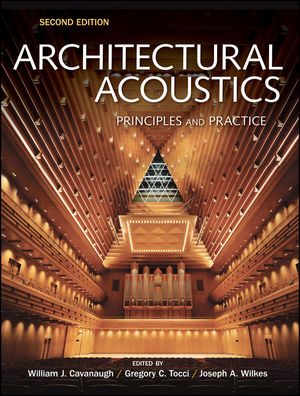Architectural Acoustics: Principles and Practice, 2nd EditionISBN: 978-0-470-19052-4
Hardcover
352 pages
November 2009
 This is a Print-on-Demand title. It will be printed specifically to fill your order. Please allow an additional 10-15 days delivery time. The book is not returnable.
|
||||||
Preface.
About the Authors.
Acknowledgments.
Chapter 1 Introduction to Architectural Acoustics and Basic Principles (WILLIAM J. CAVANAUGH).
1.1 Introduction.
1.2 Basic Concepts.
1.3 Design Criteria.
1.4 Selected Standards in Building Acoustics.
Further Reading.
CASE STUDY: Fogg Art Museum Lecture Hall, Harvard University (1895–1973) 33.
Chapter 2 Acoustical Materials and Methods (REIN PIRN AND JEFFREY L. FULLERTON).
2.1 Introduction.
2.2 Sound Attenuation.
2.3 Sound Absorption 44.
2.4 Common Building Materials.
2.5 Acoustical Materials.
2.6 Special Devices.
2.7 Performance Tables.
References.
Further Reading.
Selected Web Resources.
CASE STUDY: Duke University Chapel: A Lesson on Acoustical Materials.
CASE STUDY: Boston Waterfront Development Under a Flight Path: Sound-Isolating Façade.
Constructions to Reduce Intrusive Noise.
CASE STUDY: Berklee College of Music: Sound-Isolating Constructions Between Percussion Studios.
Chapter 3 Building Noise Control Applications (GREGORY C. TOCCI).
3.1 Introduction.
3.2 Acoustical Analysis.
3.3 Standards Organizations for the Building Industry.
3.4 Overview of Building Noise Control Design.
3.5 Heating, Ventilating, and Air-Conditioning System Noise Control.
References.
Further Reading.
CASE STUDY: Mechanics Hall, Worcester, Massachusetts: Cooling Tower Sound Isolation.
CASE STUDY: Field Impact Insulation Class Rating Measurements of Condominium Floor/Ceiling Construction.
CASE STUDY: Noise Insulation Class Rating Measurements of a Hotel Guestroom Door.
CASE STUDY: 500 Atlantic Avenue Hotel/Condominium Building Vibration Isolation.
Chapter 4 Acoustical Design: Places for Listening (L. GERALD MARSHALL).
4.1 Introduction.
4.2 Sound Outdoors and Transition to Indoor Acoustics.
4.3 Concert Halls and Recital Halls.
4.4 Opera Houses, Theaters, General-Purpose Auditoriums, and Worship Spaces.
4.5 Other Places for Speech and Music Activities.
References.
Further Reading.
CASE STUDY: Holy Cross Church, Dewitt, New York.
CASE STUDY: Mitchell Hall at the University of Delaware, Newark, Delaware—Historic Renovation.
CASE STUDY: The New Hitchcock Presbyterian Church, Scarsdale, New York.
CASE STUDY: Katherine M. Elfers Concert Hall at the Esther Eastman Music Center, Hotchkiss School, Lakeville, Connecticut.
CASE STUDY: Ozawa Hall, Tanglewood Music Center, Lenox, Massachusetts.
CASE STUDY: Hollywood Bowl Stage Redesign, Los Angeles, California.
Chapter 5 Sound Systems (MATTHEW J. MOORE).
5.1 Introduction.
5.2 Loudspeaker Systems.
5.3 Equipment.
5.4 Examples of Sound Reinforcement and Reproduction Systems.
5.5 Special Sound System Installations.
Further Reading.
CASE STUDY: Hanover Theatre, Worcester, Massachusetts.
CASE STUDY: Agganis Arena and Boston University Fitness and Recreation Center, Boston, Massachusetts.
CASE STUDY: Ave Maria University Oratory, Ave Maria, Florida.
CASE STUDY: University of Connecticut Student Union, Storrs, Connecticut.
CASE STUDY: Rhode Island Senate Chamber, Providence, Rhode Island.
CASE STUDY: Rhodes Arts Center, Northfield Mount Hermon School, Gill, Massachusetts.
CASE STUDY: Tufts University Granoff Music Center, Medford, Massachusetts.
CASE STUDY: Jay Pritzker Music Pavilion, Chicago, Illinois.
Chapter 6 Recent Innovations in Acoustical Design and Research (GARY W. SIEBEIN AND BERTRAM Y. KINZEY, JR.).
6.1 Introduction.
6.2 Understanding and Measuring Room Acoustic Qualities.
6.3 Acoustical Modeling and Aural Simulation.
6.4 Other Directions in Architectural Acoustics Research.
6.5 Conclusions.
References.
Further Reading.
CASE STUDY: Recent Halls for the Performing Arts and Acoustical Model Studies.
CASE STUDY: Segerstrom Hall, Orange County Performing Arts Center, Orange County, California.
CASE STUDY: McDermott Concert Hall, Morton H. Meyerson Symphony Center, Dallas, Texas.
CASE STUDY: Evangeline Atwood Concert Hall, Alaska Center for the Performing Arts, Anchorage, Alaska.
CASE STUDY: Bass Performance Hall, Fort Worth, Texas.
CASE STUDY: The Esplanade Concert Hall, Theaters on the Bay, Singapore.
CASE STUDY: Tokyo Opera City Concert Hall, Takemitsu Memorial, Tokyo, Japan.
CASE STUDY: Walt Disney Concert Hall, Los Angeles, California.
CASE STUDY: Computer Model Tests.
Chapter 7 Sustainable Design and Acoustics (ETHAN SALTER, LEED AP).
7.1 Introduction.
7.2 Organizations Leading the Green Building Movement.
7.3 Acoustical Challenges of Green Design.
7.4 Postoccupancy Evaluations of Green Buildings.
7.5 Examples of Building Types Designed for Green Ratings.
7.6 Conclusion.
References.
Further Reading.
Internet and Web Resources.
CASE STUDY: Global Ecology Research Center at Stanford University, Palo Alto, California.
CASE STUDY: Dougherty Valley High School, San Ramon, California.
CASE STUDY: Charles Salter Associates Tenant Improvement Office, San Francisco, California.
Appendixes.
Appendix A: Conversion Factors, Abbreviations, and Unit Symbols.
Appendix B: Acoustical Societies Throughout the World.
Appendix C: Selection of an Acoustical Consultant.
Appendix D: Self-Study Guide for Using this Book.
Glossary.



